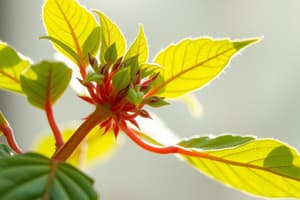Podcast
Questions and Answers
What is the overall reaction for photosynthesis?
What is the overall reaction for photosynthesis?
6 CO2 + 6 H2O ==> 6 O2 + C6H12O6
How does this compare to the overall reaction for cellular respiration?
How does this compare to the overall reaction for cellular respiration?
They are opposites.
Where does the energy for photosynthesis come from?
Where does the energy for photosynthesis come from?
The sun, or solar energy.
What plant pigments are involved in photosynthesis?
What plant pigments are involved in photosynthesis?
Explain why chlorophyll appears green to us.
Explain why chlorophyll appears green to us.
How does the amount of energy in light change as the wavelength increases?
How does the amount of energy in light change as the wavelength increases?
Which colors of light are most effective for photosynthesis?
Which colors of light are most effective for photosynthesis?
In what organelle of plant cells does photosynthesis take place?
In what organelle of plant cells does photosynthesis take place?
What are the two stages of photosynthesis?
What are the two stages of photosynthesis?
In which part of the chloroplast does each stage of photosynthesis occur?
In which part of the chloroplast does each stage of photosynthesis occur?
What happens to water molecules in the light reactions?
What happens to water molecules in the light reactions?
What photosynthesis waste product is formed in the light reactions?
What photosynthesis waste product is formed in the light reactions?
What two products of the light reactions are used up in the Calvin cycle?
What two products of the light reactions are used up in the Calvin cycle?
What happens to carbon dioxide molecules in the Calvin cycle reactions?
What happens to carbon dioxide molecules in the Calvin cycle reactions?
How can cells store the sugar that is produced in photosynthesis?
How can cells store the sugar that is produced in photosynthesis?
What are the three parts of the Calvin cycle?
What are the three parts of the Calvin cycle?
What do light reactions produce?
What do light reactions produce?
What happens to the electrons in light reactions?
What happens to the electrons in light reactions?
What happens in the Calvin cycle?
What happens in the Calvin cycle?
How many photosystems do light reactions use?
How many photosystems do light reactions use?
What does PS-I do?
What does PS-I do?
What does PS-II do?
What does PS-II do?
What is photosynthesis?
What is photosynthesis?
Flashcards are hidden until you start studying
Study Notes
Overall Photosynthesis Reaction
- Photosynthesis equation: 6 CO2 + 6 H2O → 6 O2 + C6H12O6 + light energy.
- Involves converting carbon dioxide and water into glucose and oxygen.
Comparison to Cellular Respiration
- Photosynthesis and cellular respiration are opposite processes.
- Photosynthesis produces glucose and oxygen, while cellular respiration consumes them.
Energy Source
- The primary energy source for photosynthesis is sunlight or solar energy.
Plant Pigments
- Key pigments involved in photosynthesis include chlorophyll a, chlorophyll b, and carotenoids.
- These pigments aid in the absorption of light energy.
Appearance of Chlorophyll
- Chlorophyll reflects green light while absorbing red and blue light, leading to its green appearance.
Wavelength and Energy Relationship
- As wavelength increases, the energy content of light decreases; longer wavelengths have less energy.
Effective Light Colors for Photosynthesis
- Red and blue/violet light are most effective for photosynthesis.
- These colors are absorbed efficiently by chlorophyll pigments.
Location of Photosynthesis
- Photosynthesis occurs in chloroplasts, specialized organelles in plant cells.
Stages of Photosynthesis
- Two main stages: light reactions (light-dependent) and the Calvin cycle (light-independent).
Chloroplast Compartments
- Light reactions take place in the thylakoid membrane.
- Calvin cycle occurs in the stroma of the chloroplast.
Water in Light Reactions
- Water molecules are split, and the electrons generated go to photosystem II.
Waste Product of Light Reactions
- Oxygen is produced as a waste product during the light reactions.
Products Utilized in the Calvin Cycle
- The light reactions generate NADPH and ATP, which are utilized in the Calvin cycle.
Carbon Dioxide in the Calvin Cycle
- Carbon dioxide is transformed into sugar (glucose) in the Calvin cycle.
Sugar Storage
- Cells store the glucose produced in photosynthesis as starch for energy reserves.
Parts of the Calvin Cycle
- Three stages: CO2 fixation, CO2 reduction, and regeneration of RuBP.
Products of Light Reactions
- Light reactions generate ATP and NADPH, essential for energy transfer.
Electron Flow in Light Reactions
- Energized electrons move through the electron transport chain, pumping protons (H+) and synthesizing ATP from ADP.
Calvin Cycle Overview
- Carbon dioxide binds to a 5-carbon molecule, resulting in a 6-carbon compound.
- This process, catalyzed by Rubisco, requires NADPH and ATP.
- The 6-carbon structure is converted into carbohydrates and regenerates RuBP.
Photosystems in Light Reactions
- Two photosystems are involved: Photosystem I (PS-I) and Photosystem II (PS-II).
Function of Photosystem I
- PS-I captures light energy and releases an electron, which contributes to NADPH production.
Function of Photosystem II
- PS-II captures light energy, initiating the process of photosynthesis.
Definition of Photosynthesis
- Photosynthesis is the process of capturing solar energy and converting it into chemical energy, stored in carbohydrates.
Studying That Suits You
Use AI to generate personalized quizzes and flashcards to suit your learning preferences.




